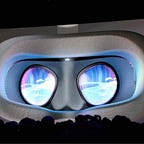We went hands on with the StarVR One
It’s the new wider & taller VR headset with higher resolution and eye tracking, watch the video to hear some first impressions about the display. Since we were at Siggraph 2018 in Vancouver we also took a few photos and decided to describe the experience of Siggraph a little bit so you have some idea.
Field Reporting and Opinions about the Star VR One headset by Jeremy Owen Turner. Text & Video Editing by Micah Blumberg
SIGGRAPH 2018 is the world’s leading annual interdisciplinary educational event showcasing the latest in computer graphics and interactive techniques. The 45th SIGGRAPH conference took place 12–16 August at the Vancouver Convention Centre and featured 16,500 attendees around the world.
Watch “We went hands on with the StarVR One” here: https://www.youtube.com/watch?v=qOBwZnNBZnI
Alternate version of the same video directly below:
Also introduced at the show was the StarVR One XT and the key difference is that the Star VR One uses the Valve Lighthouse 2.0 Tracking system and Vive like controllers. While the “Star VR One XT” Version uses VR arcade style motion tracking systems that are much more expensive.
The original Star VR headset had a 170 degree FOV which was pretty amazing to have such a wide FOV in VR when I tried it years back with the Walking Dead demo. So I was surprised to find out that the new Star VR One has a 210 Field of View, but it’s also taller with a verticle 130 FOV.
I really like wide FOV headsets having tried the original Star VR and also the Pimax 8k, (some estimate the resolution of the Star VR One to be 5k (or 16 million subpixels) but Star VR One differs greatly from the Pimax 8k for several reasons. It can do an actual 90hz. (Pimax does only 88hz) and it includes the Tobii eye tracking which can do three really important things (depending on the developer to implement).
With Tobii eye tracking
1. It can do auto IPD which means it will automatically calibrate itself to match your interpupillary distance, so it looks the best every time you put it on, even after sharing it with someone else.
2. Eye Tracking for foveated rendering so you could exceed the visual quality you might see on a system with the same graphics card but a similar display size and resolution but no foveated rendering. I am personally very excited about the improvement in visual quality and performance power that foveated rendering gives to VR users.
3. With Eye Tracking your avatar in VR has eyes that move correctly, and the developer can predict things like which objects you feel intensely about and perhaps want to click on or push away with eye tracking, this is great for Neurohacking developers who may for example want to learn (with neural networks) more about individual users to modify programs to make better experiences.
Check out this paper if you want to know more about what eye tracking brings to VR http://www.moorinsightsstrategy.com/research-paper-the-importance-of-eye-tracking-in-augmented-reality-ar-and-virtual-reality-vr/
Star VR is getting a lot of support from major VR application tool sets such as Unreal Engine 4, Autodesk, Otoy, Zerolight and many more, and the company will be announcing pricing soon.
